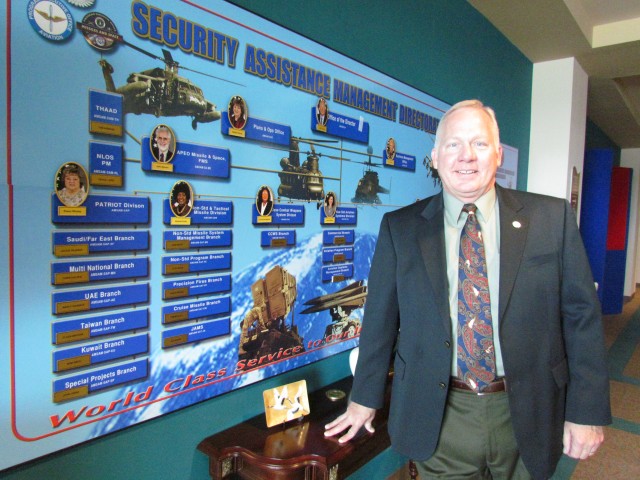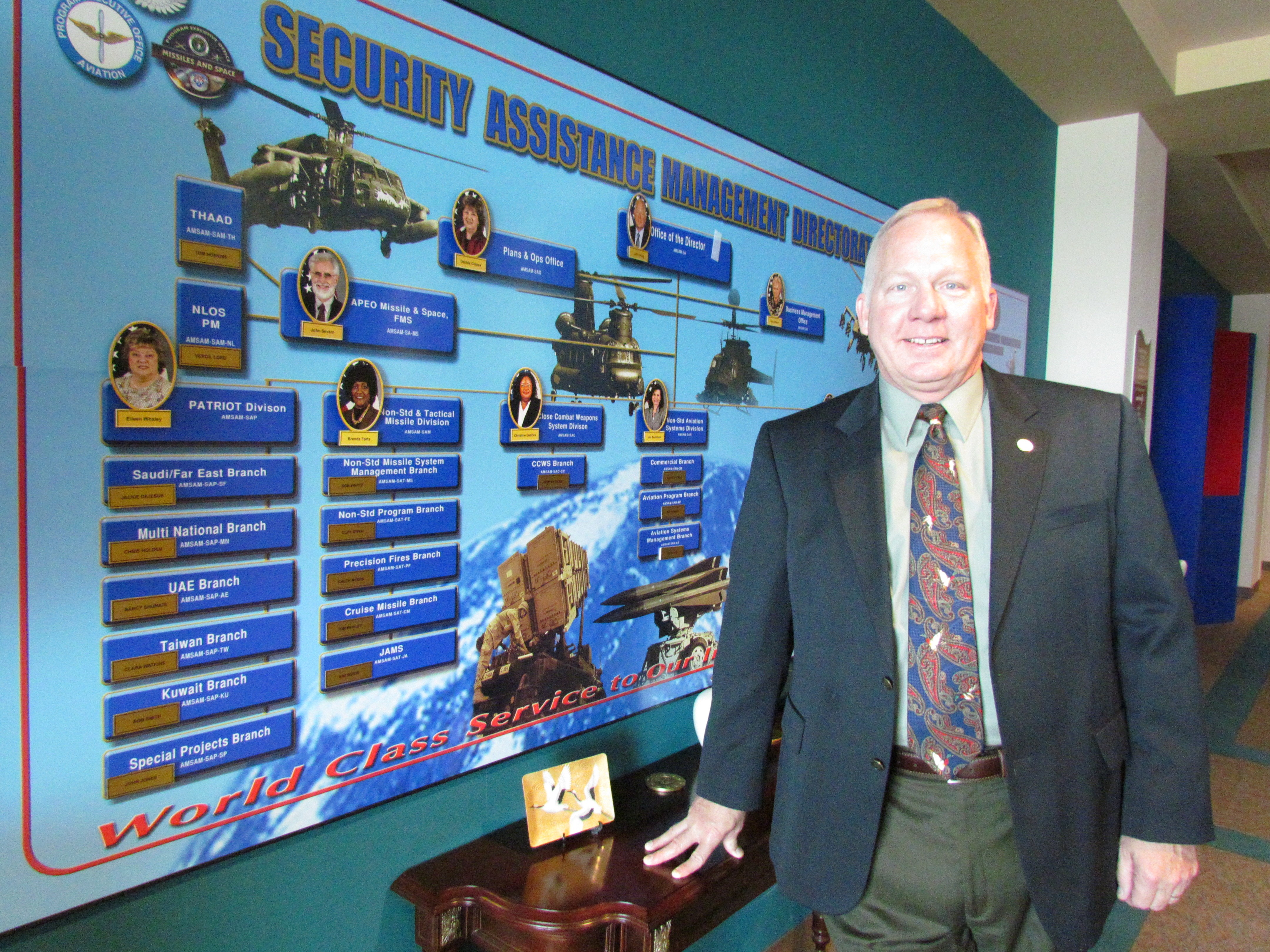
from April 2009 to August 2010, now serves as the director of AMCOM's Security Assistance Management Directorate. SAMD is responsible for managing foreign m... VIEW ORIGINAL
REDSTONE ARSENAL, Ala.--"Selling" the idea of foreign ownership of U.S. hardware is easy in the worldwide market. The reputation of high quality missile and aviation systems combined with the best technical, maintenance, training and logistics support makes the Army's equipment a popular commodity among U.S. allies.
But when it comes down to the nitty gritty of a U.S.-friendly purchase - solidifying working relationships with foreign governments, negotiating pricing and contracts, obtaining equipment, working the details of training and system support, delivering equipment on time and providing technical and maintenance support after the acquisition - the employees of the Aviation and Missile Command's Security Assistance Management Directorate must be "jacks of all trades" to turn a foreign military sale into reality.
"It's a complex business because we have to blend in our work with what the program managers do and what acquisition does in supporting the security assistance mission," said Jeff Young, the new director of SAMD. "We are part of the security assistance enterprise to manage foreign military sales cases, with one foot in the aviation and missile materiel enterprise and one foot in the security assistance enterprise. We can't bring to fruition our activities without the help of the program managers, acquisition community and Security Assistance Command."
A lot of what SAMD can do to support the acquisition requests of foreign allies depends on the military platform that is being considered for purchase.
"The program manager is responsible for acquisition for the Army's mission," Young said. "Main systems that are in the program manager's product line become the focal point of our work. We coordinate foreign military sales contracts based on those product lines and we work with other life cycle management commands to get all the ancillary product lines (in support of the main product line) on contract and on an integrated master time line that meets what the customer is expecting."
Since taking over the management of SAMD in September, Young, a retired colonel, has been on the front lines of AMCOM's foreign military sales cases. All Army materiel enterprises - such as
AMCOM, the Tank-Automotive Armament Command and the Communications-Electronics Command -- have SAMD organizations, and all of them work in support of both their command and the Security Assistance Command, which implements approved Army security assistance programs, including foreign military sales to eligible foreign governments from development to execution, financial management, accounting and closure. The command manages about 4,600 foreign military sales cases each year valued at $118 billion.
AMCOM's SAMD draws in significant foreign military sales numbers, making it one of the largest contributors to the overall Security Assistance Command goal of providing military systems to assist foreign allies in the defense of their borders and their country's freedom. In fiscal 2010, SAMD managed $4 billion in new foreign military sales cases. Halfway through fiscal year 2001, SAMD has initiated $5.7 billion in foreign military sales cases, and is expected to exceed $10 billion for the fiscal year.
Yet, overall, the power of SAMD can be deceiving. Its 280 employees are scattered, taking up shop within program management offices to provide the best support to allied governments. Three divisions of SAMD employees are located with missile systems programs, while another three divisions are located with aviation systems programs. Many SAMD employees work directly with government officials overseas. It's an organization that has centralized planning and policy with decentralized management and execution.
"We have chosen to co-locate our SAMD case managers in program management shops to achieve synergy," Young said. "For example, with the Jordanian Black Hawk case, we have our SAMD case manager working alongside Black Hawk engineering, logistic and acquisition people who already have the Black Hawk under a production contract for the U.S. Army.
"By working the U.S. contract and the Jordanian case at the same time, we can economically order quantity at a higher level. We build foreign military sales Black Hawks to a green (Army) configuration alongside normal Army unit Black Hawks. At the end of the line, it splits, with different packages and different modifications going on each of the aircraft."
Leading a geographically disbursed organization can be difficult, Young said, but it's the best type of organization for both the success of SAMD's programs and its employees.
"Successful employees have a career program that gives them experience in multiple systems and at multiple levels," Young said. "That kind of experience makes our employees better at what they do, whether they are working on aviation or missile systems foreign military sales cases.
"Our employees have to know a little bit about a lot - a little engineering, programatics, logistics, training and a good bit of acquisition. Employees have to be a mile deep in case development, writing and management. They are the subject matter experts in the security assistance apparatus."
Young describes SAMD employees as "dual citizens in two lands."
"We're equally comfortable talking to a program manager about original equipment and understanding the exact requirements of a foreign country," he said.
Currently, Young, too, is dual-hatted. While he leads SAMD as its director, he is also the program manager for non-standard equipment. The focus of non-standard equipment is to provide foreign allies with missile and aviation systems that are effective and available, but no longer in the Army's troop base.
For example, the Hawk missile system was removed from the Army's inventory in the '80s. But it is still an active system in 16 countries. Those countries have joined together in a cooperative fair share sustainment program, which allows them to share costs for upgrades in support and for dynamic component rebuilds.
SAMD cases also affect the strategic plans of foreign governments.
"We've got some one-year programs where we are looking for an immediate impact, where we want to have an immediate impact on a region. These programs usually are intended to counter terrorism," Young said.
"You can't procure a system in a year. But, you can take older systems not in the Army inventory anymore - the Hawk, for example, or Huey helicopters - and you can have an immediate impact. These older systems provide an economically affordable platform for a developing country that has an immediate need."
When Young stepped into the SAMD director position, he came in as a manager who had assisted in guiding SAMD's success from the AMCOM executive level. As AMCOM's chief of staff until mid-2010, Young was familiar with the external workings of SAMD.
"I had learned where the problem areas were. But I didn't know how those problem areas were necessarily worked," he said. "It takes six to eight months to fully understand the internal workings of a large organization like SAMD.
"I am learning something new about this organization every single day, about how the security assistance community works, how cases are written and managed, and how the overall timelines for engineering, acquisition, training, logistics and other functional areas related to a foreign military sale are properly arranged so that a contract can come to fruition."
Young is grateful to Dr. Tom Pieplow, former SAMD director who retired and now is a professor at Athens State University. Pieplow, he said, "left a rich legacy in the way he built the people of SAMD. He had a real vision of how to build the workforce within SAMD. He understood our demographics - our age and skill levels - and how we acquire, train and integrate our employees. It takes several years before you have a fully trained and functional security assistance specialist."
Young does see opportunities for improvement as demand for U.S. aviation and missile systems grows among foreign allies, and the U.S. security assistance goals evolve with the changing world environment.
"We want to look across the spectrum of aviation and missile programs and take the best practices out of each individual program management office and then template those across all of SAMD so we are more standardized in how we do business, and in how we fulfill our individual roles and responsibilities," Young said.
"To ensure that we continue Tom Pieplow's legacy, we want to continue to invest in our most precious resource - our people - and develop them professionally and personally, and challenge them with professional growth opportunities."
When it comes to working on big dollar contracts with foreign governments -- such as the $6.5 billion Patriot missile contract purchase by the United Arab Emirates or the $27 billion multi-system aviation case with Saudi Arabia - SAMD must rely on the expertise of the Contracting Command-Redstone, such as Cathy Dickens, director of contracting for AMCOM; and Col. Dan Cottrell along with contracting command employees.
"Contracting employees are the unsung heroes of foreign military sales. They are the last ones to get contracting actions and they never fail," Young said.
But Young said SAMD's job isn't all about selling military platforms to foreign allies.
"The work we do enables the State Department to achieve their strategic goals," he said. "The volume that we want to achieve is directly translatable to what the State's goals are with foreign governments.
"And, as the Army is decreasing its budget and looking for efficiencies, SAMD can have a positive economic impact for the Army, and the missile and aviation industry."
As a 27-year veteran of the Army, Young said his leadership position with SAMD gives him the opportunity to continue to serve the Army and the nation.
"It's a lifestyle that becomes a part of you," he said. "This is a way that I can still be part of the Army and that I can still help Soldiers on a daily basis. I wasn't ready to retire. I still wanted a challenge. The nature of this work is something that I really enjoy."

Social Sharing